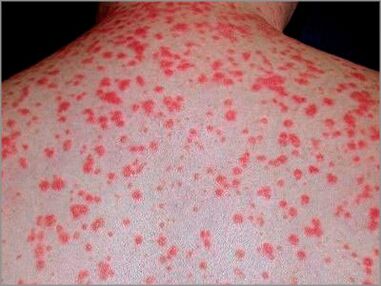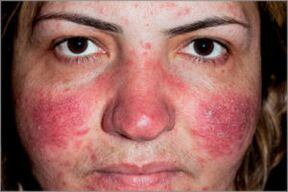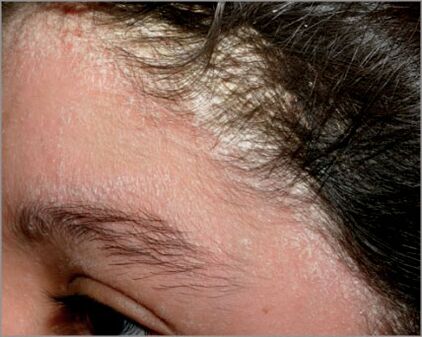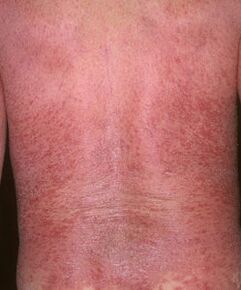People who encounter this skin disease for the first time, have very unpleasant symptoms, and want to know what psoriasis is and how to get rid of it.This is a disease that primarily affects the upper layer of the epidermis and its appendages: the nail plate, nail bed, and hair.According to statistics, psoriasis affects about 4% of the world's population.Additionally, the disease is more common at younger ages: 18 to 23 years old.
There are many conditions similar to psoriasis, so it's important to understand its symptoms to choose the right treatment.

Generally speaking, you should not treat this disease on your own because psoriasis develops very quickly and can cause serious complications.If you notice signs of disease, seeing a dermatologist is the only right decision.
Species
There are many types of this skin disease.When classifying psoriasis, the nature of the rash, the severity of the course, and the location of the lesions need to be considered.There are the following main types of psoriasis:
- Plaque psoriasis (common).This is the most common type of disease, occurring in 85% of patients.It is characterized by gray or silvery-white patches on the skin surface that fall off easily.Psoriasis vulgaris is another name for this disease.
- Guttate psoriasis.The destructive elements in this type of disease resemble droplets or dots ranging from red to purple.
- Pustular psoriasis.The most severe form of this skin disease.It is characterized by the appearance of pustules - blisters filled with clear, non-infectious fluid - on the body.As the disease progresses, the fluid becomes purulent.
- Psoriatic nail damage (onychodystrophy).Symptoms of this form of psoriasis affect the nail plate and the area around it: changes in the color of the nail, spots appearing on its surface, thickening of the skin around the bed, cracking and delamination of the nail plate.
- Arthropathic psoriasis.The disease is characterized by inflammation of the facet joints.This form of psoriasis most often causes disability.
- Inverse psoriasis (folded or inverted).The disease affects the skin folds in the groin area, inner thighs, armpits, and under the breasts (in women).
- Palmoplantar psoriasis.As the disease progresses, all the characteristic symptoms begin to appear on the feet and hands.In severe cases, the disease can affect the nails and other parts of the body.
- Seborrheic psoriasis.With this form, the rash is concentrated on the head, face, and back.

disease symptoms
What does psoriasis look like?How not to confuse it with other skin conditions?In the initial stages of the disease, psoriasis can present with the following symptoms:
- Pink, red, or blue papules appear on the skin, symmetrically distributed in specific areas of the body;
- general weakness;
- chronic fatigue;
- Depression or apathy.
Gradually, the rash coalesces into plaques - scaly structures that are easily removed.The inflamed area grows toward the edges.
During this stage of psoriasis, there are some signs that can help distinguish this disease from other skin conditions.If the scales are scraped off, the phenomenon known as the psoriasis triad can be observed, consisting of the following symptoms:
- Stearin staining: After scraping off the bacterial plaque, silver-white scales are separated, similar to stearin shavings;
- Terminal film: A very thin, shiny film is left at the site formed by scraping, covering the papules;
- "Blood dew": Pinpoint bleeding may occur at the site where the terminal membrane is removed, which is caused by damage to the subcutaneous vascular network.
Symptoms of psoriasis vary depending on the specific stage of the disease and the season.For most patients, the symptoms of psoriasis worsen during the winter.The "summer" form of the disease is quite rare, as patients' condition improves under the influence of ultraviolet radiation.
What are the different stages of psoriasis?There are a total of 3 stages of disease development.

- In the progressive stage, new rashes appear and existing patches grow in size.The patient experienced severe itching and constant peeling of the skin.
- What does the quiescent phase of psoriasis look like?During this period, the papules stop growing.Small folds were observed in the patchy area.Still have severe itching.
- In the regression phase, plaques begin to disappear, peeling disappears, and itching is no longer tormenting.Areas of pigmentation may occur at the site of strata.
Certain types of psoriasis have unique symptoms.
For example, when the scalp is affected, dandruff-like patches first appear.In this case, only the skin is affected; the condition and growth of the hair are not affected by the disease.The rash spreads from the head to behind the ears, neck and forehead.
When psoriasis occurs on the palms and feet, the skin becomes thickened and cracked.In the early stages of the disease, pustules with transparent contents are formed, which gradually turn into suppuration.Later, scars appear at the site of such formation, causing discomfort and pain during physical activities (working with hands, walking).In the future, the disease can spread to the backs of the hands and fingers.
Nail psoriasis is described as follows: First, the nail plate is covered with small depressions, reminiscent of needle marks, becomes discolored, and begins to peel and peel.The tissue around the nail becomes thickened and inflamed.
main reason
To date, the pathogenesis of psoriasis has not been fully studied.Scientists have proposed several theories as to why the disease occurs.There are two main causes of psoriasis.

- The cause of the disease is immune system dysfunction.Cells designed to protect the body from bacteria and viruses enter the upper layers of the epidermis, where they produce substances that trigger the inflammatory process.As a result, skin cells divide rapidly and the affected area thickens.This theory is supported by research on psoriatic plaques, which revealed a massive accumulation of immune cells.
- The skin disease psoriasis is caused by impaired division and maturation of epithelial cells.As a result of this pathology, diseased skin cells are attacked by immune cells.
The development of psoriasis is influenced by many factors.If the body is affected by the following conditions at the same time, the risk of illness increases.
- The skin is dry and thin.Experts point out that people with thick, oily and moist skin rarely develop psoriasis.This is due to the structural characteristics of the epidermis and the protective function of sebum.
- Excessive love of hygiene.There is an unreasonable desire to constantly keep the body clean, and using soap and towels too frequently can damage the skin and reduce its protective properties.
- bad habits.When smoking and drinking alcohol, the condition of the epidermis worsens: subcutaneous blood circulation and tissue nutrition are disrupted.
- External negative factors.According to statistics, skin diseases mostly occur in people who are often exposed to detergents, daily chemicals, alcohol solutions, etc.
- drug.Long-term use of certain medications, such as antidepressants and anticonvulsants, may cause psoriasis symptoms.
- infectious disease.Usually, pathology occurs immediately after diseases caused by fungi or staphylococci.
- climate change.It happens that for the development of psoriasis, moving to a different climatic zone is enough.
- Skin damage.Regularly wearing uncomfortable clothing with rough seams or poor quality shoes and the habit of scratching the same area may cause the first symptoms of psoriasis to appear.
- pressure.Psychological and physical shocks to the body (e.g., prolonged hypothermia) may precede the onset of illness.
- Severe eating disorders.Abuse of sweets, carbonated drinks, citrus fruits, bacon and salty foods may complicate the course of the disease.
- Genetic predisposition.Is it possible for psoriasis to be hereditary?According to scientists, genes responsible for immune system activity are carriers of the disease.This is why the disease can be passed from parents to children.

Life with psoriasis
Although psoriasis is not a contagious disease and cannot be spread through physical contact with sufferers, many sufferers consider themselves social outcasts, which is why they experience severe psychological distress.
The biggest problem is a rash on the head, ears and face.More than half of patients often focus on their appearance, fearing public condemnation and social rejection because psoriasis often looks like lichen.As the disease progresses, communication between people becomes limited.Only a quarter of people with psoriasis do not feel stressed about their appearance.
The disease can also cause severe physical discomfort.Persistent itching and burning limit the patient's ability to work, interfere with proper rest, often lead to insomnia, and interfere with movement.Psoriatic arthritis adds to the unpleasant symptoms of joint pain.
Psychological anxiety combined with physical discomfort can lead to severe depression, and some patients even develop social phobia.Long-term and expensive treatment of the disease can also have a negative impact on patients, in addition to weakening their physical strength and interfering with their social interactions.
Why is psoriasis dangerous?
In the initial stages, the disease causes discomfort and is accompanied by the following symptoms: itching, burning, peeling.
If psoriasis is not treated, the disease will progress to an advanced stage, posing danger to the patient's health and even life.
In many cases, the following dangerous complications occur:
- Pathological changes in metabolic processes;
- Deterioration of heart function and risk of stroke and myocarditis;
- Interference in the activity of the kidneys and liver;
- Joints affected (most commonly phalanx of fingers, elbows, knees);
- Mucous membranes affected: eyes, gastrointestinal tract, bladder;
- With severe psoriasis, the brain and nervous system are affected;
- Potency may be diminished in men;
- As plaques spread throughout the skin, the respiratory function of the skin and the activity of sweat and fat glands are disrupted;
- Thermoregulation is disrupted, leading to inflammation of the epidermis, which can lead to blood poisoning, leading to death.
The consequence of an exacerbation of the condition may be erythroderma.
This complication occurs in only 2% of all patients.In the initial stage, it is characterized by the appearance of bright red lesions on the skin, reminiscent of burns.Over time, these areas will develop scales and flake off in large areas.The skin in the area becomes very hot and very sensitive.Other symptoms may occur: tightness, persistent itching, brittle nails, severe hair loss, and swollen lymph nodes.
If you notice signs of psoriasis, you should contact your dermatologist immediately.The diagnosis is made based on external examination of the skin and nails.No additional testing is usually specified.If a patient complains of joint pain, X-rays and blood tests are done to rule out other types of arthritis.
Only a doctor can make a correct diagnosis and decide how to treat psoriasis.
Treatment
It should be noted right away that psoriasis cannot be completely cured.
Winston Churchill also said: “I will erect a solid gold monument to those who are able to learn everything there is to know about psoriasis and find an effective treatment for this disease.”
topical preparations
Regardless of the cause of psoriasis, first, your doctor will prescribe topical treatments that can help relieve uncomfortable symptoms.First, use non-hormonal lotions, ointments, and creams that contain tar, oil, zinc, or herbs.In most cases, such medications help forget about the negative symptoms of psoriasis after 3-4 weeks of use.
If non-hormonal creams don't work, hormonal psoriasis medications are used.It must be used strictly in accordance with the expert's prescription, and no overdose or extended course of treatment is allowed.With the help of hormonal ointments, you can quickly forget what it is - psoriasis, but there is a high risk of serious side effects.
Even the latest local medicines must be combined with other drugs.In addition to ointments, intestinal adsorbents (which remove toxic substances from the tissues) and immunosuppressants (designed to reduce the immune system's response) are also prescribed.Treatment is impossible without taking a multivitamin, especially vitamins B, A, C, D.

physical therapy
These psoriasis treatments are widely used in all stages of the disease.Treatments such as bathing, phototherapy, and ultraviolet irradiation are extremely effective.
New treatments for the disease include cryotherapy, electrosleep therapy, leech therapy and PUVA therapy.
In advanced forms of the disease, the use of ultraviolet light has good results.With this method, in just 20-30 surgeries, damaged cells are destroyed, peeling is eliminated, damaged skin is repaired, and the immune system returns to normal.Before a full surgery is performed, a trial is performed in which a small part of the patient's body is exposed to radiation.If skin reaction is normal, proceed to full course of treatment.During the summer, patients can continue to receive UV treatments under natural sunlight.
traditional medicine
Folk remedies for any type of psoriasis should only be used after consulting a doctor.
It's important to understand that severe symptoms of psoriasis cannot be eliminated at home.
Traditional recipes can only help soften flaky skin and temporarily relieve itching.The following products have received the best reviews from patients.
tar:
- At the early stage of the disease, apply tar to the affected area with a cotton swab for 10 minutes, then wash it off with tar soap;
- On days 4-5, increase procedure duration to 40 minutes;
- The entire treatment course is 12 days;
- It is best to use tar before bed, as its smell disappears completely during the night.
Celandine:
- Uproot several celandine bushes through a meat grinder;
- Squeeze the juice from the resulting mass;
- Lubricate each affected area of the body with juice;
- This process is repeated until the external symptoms of the disease completely disappear.
Eggs and vinegar:
- Beat 2 eggs and 20 ml vegetable oil to make an ointment;
- To this substance add 10 ml of acetic acid;
- Use the resulting product to lubricate rashes and patches every night;
- Treatment duration: 3-4 weeks.
Herbal medicine:
- Grind 20 grams of Hypericum perforatum flowers, 20 grams of celandine root, 10 grams of marigold flowers and 10 grams of propolis into a paste (preferably in a clay bowl);
- Add 20 ml of vegetable oil to the medicinal materials;
- Apply the prepared product to the affected area 3 times a day;
- You can stop treatment once the visible signs of the disease disappear.
Elderberry Infusion:

- Pour 0.5 liters of boiling water into 10 grams of elder leaves and flowers;
- Leave the infusion at room temperature for half an hour;
- If itching worsens after meals, infuse 80 ml each time;
- Duration of treatment - 10 days.
diet
No matter what method you use to treat psoriasis, you're unlikely to see much improvement without following a special diet.To adjust the diet, it is best to contact a specialist, who will prepare a menu based on the personal characteristics of a specific patient.To ensure that the entry "psoriasis" no longer appears in the medical history, you should know and follow the general rules of patient nutrition.If you suffer from this disease, the following diseases should be excluded from the menu:
- any nuts;
- citrus;
- bacon;
- spices;
- salinity;
- spicy dishes;
- fatty foods;
- Alcohol;
- Blue cheese.
If your medical history includes a diagnosis of psoriasis, you'll want to make sure you eat a balanced diet.Food that provides the body with all the necessary substances should be on the table every day.
It is especially important to get fatty acids, which are found in adequate amounts in all types of fish.
Advice to patients
In order to forget for a long time which disease afflicts you, no matter what kind of psoriasis you have, follow these important rules during and after treatment:
- Use gentle skin care: wash with warm water and mild products, do not wipe your body with a towel, but gently blot dry;
- Give up your regular cosmetics for a while and avoid using new products;
- Wear protective gloves when doing any household chores;
- Limit exposure to allergens;
- Wear clothes and shoes made of natural fabrics without rough seams;
- Drink at least 1.5 liters of clean water every day.
You need to understand that it is impossible to completely cure psoriasis.However, if you choose the right approach to combat this disease, you can get rid of its unpleasant symptoms and achieve stable remission.
Keep your skin clean, watch for the slightest changes in skin condition, and contact a specialist if you develop suspicious symptoms.Taking good care of your body will keep you healthy and beautiful at all times.To stay up to date with the latest interesting information and current news, subscribe to our articles and be sure to share them with your friends on social networks.goodbye!
This article has unique educational, encyclopedic, and informational functions.It is necessary to obtain your doctor's approval before using the tips and suggestions described in this article.You should not self-medicate!
























